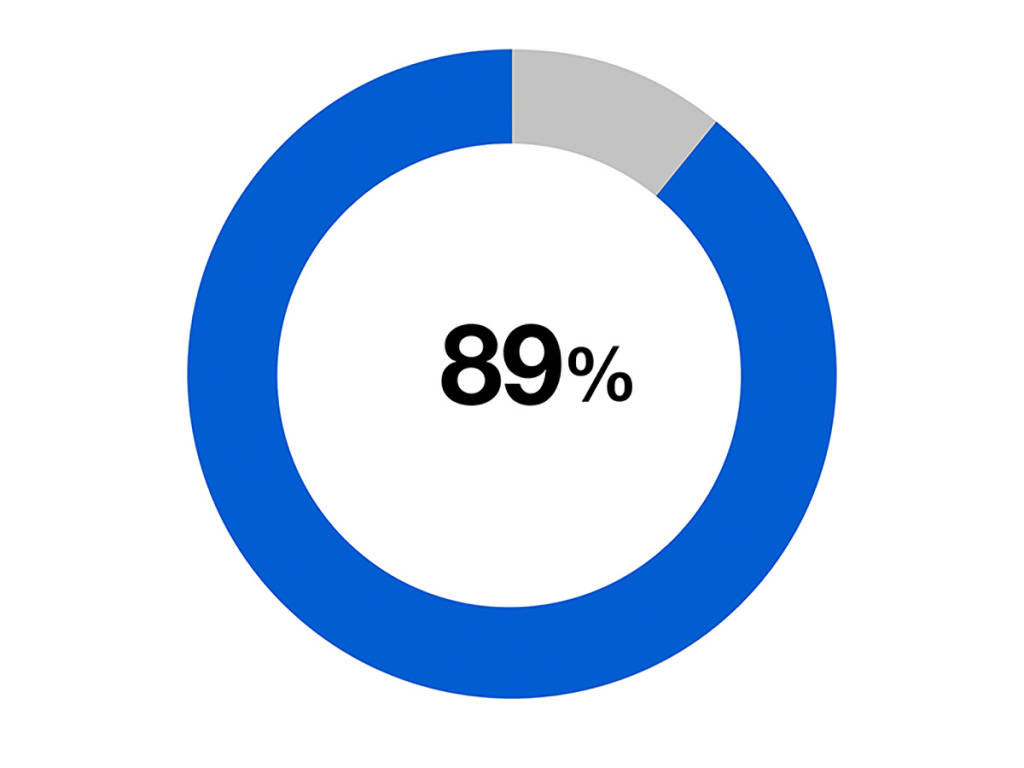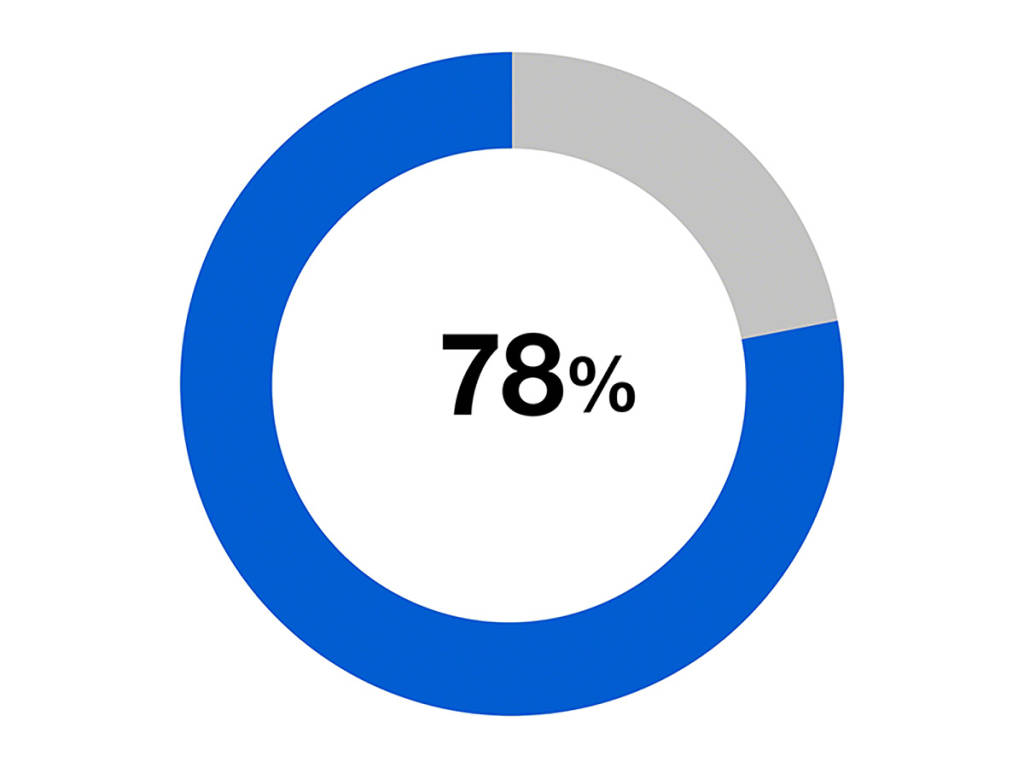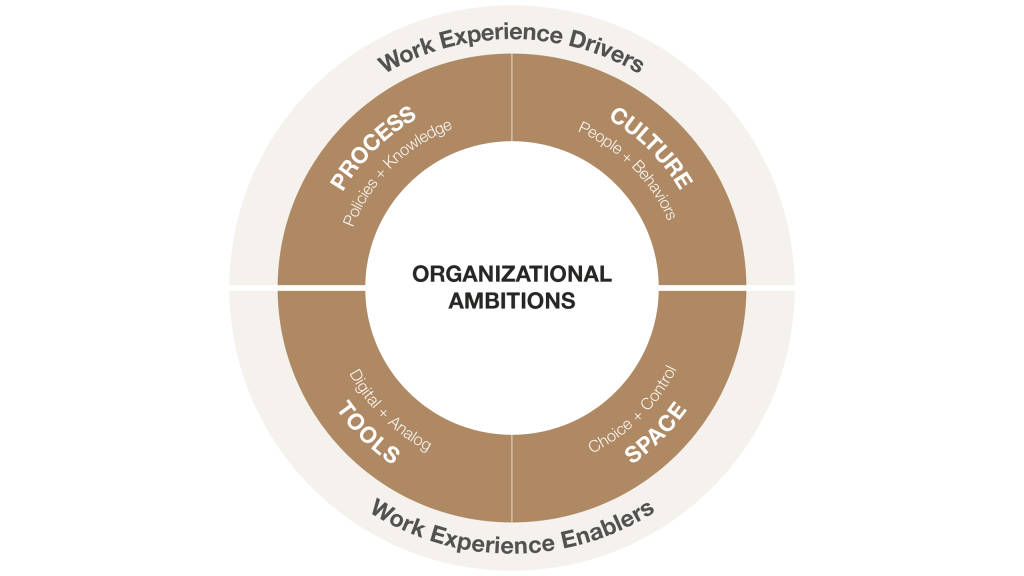Hybrid Work: Creating Great New Work Experiences
Helping people work better in the hybrid future of work.
Even before the pandemic, some organizations began experimenting with mobile work — for example, shifting the ownership for spaces and offering more choice and control, expecting people to move about a campus and select where they worked based on their activities and tasks. And some companies also employed hybrid work, giving employees flexibility in working from home when warranted. Now, the practice has become the mainstream for many organizations — even those who believed it wasn’t a fit for them.
Whatever the ultimate scope of hybrid work, there can be no question the pandemic greatly compressed the timeline for widespread adoption.
Hybrid work is not practical for every company or job type, of course, but any organization for which it is feasible will likely have to offer it — or watch talent drift to competitors that do. Studies show that the freedom to work remotely is a significant part of the value equation when employees weigh the pros and cons of prospective employers.
Now more than ever, employees enjoy significant influence with employers and within the job market. A talent revolution was underway well before the pandemic hit. Demand exceeds supply, partially because technology-assisted mobility means skilled workers can cast a wide net for job prospects. For employees, there are greater opportunities to move away from major metropolitan areas to lower cost areas, because proximity to a workplace matters less than it once did. For employers, competition for talent comes from everywhere, not just companies located nearby.
Having experienced the convenience of working from home, employees know they are in a strong position to demand continued flexibility in their working arrangements. Meanwhile, employers are well-aware they are confronting a seismic shift in employee expectations.
Hybrid work is here to stay and the ability to work in the office as well as at home or remote locations can be the best of both worlds — but only when it is a fit to an organization’s culture, is managed well and part of an effective overall work experience.
A Steelcase study found:
In planning a hybrid approach, it’s best to remember that both in-person and remote work have benefits, and both have a place in the work experience.
Overview of hybrid work models
When adopting a hybrid work strategy, organizations can structure the arrangement in multiple ways, depending on what works best for their business. Some organizations prefer the traditional approach—everyone in the office all the time. Others are moving in the opposite direction, allowing employees to work away from the office whenever they want with no restrictions.
Most organizations, though, fall somewhere between, experimenting with some variation of the following:
Days of the week. In this model, the employer specifies how many days each week employees must work in the office—typically three, though it could be more or fewer. This provides flexibility to accommodate the needs of both teams and individuals. Some companies set the number of days in the office and then allow team leaders to determine which days of the week will be inoffice days.
In other cases, organizations are being more specific about the days of the week people must be in the office. For example, people might be expected in the office Tuesday through Thursday, and free to work at home Monday and Friday. This approach gives employees the flexibility to work alone while maintaining the competitive and cultural benefits of working together. The fixed schedule makes it easier to coordinate in-person meetings.
Number of weeks per month. Some organizations want employees present for a full week at a time, often either one or two weeks each month. The specific weeks in question are either mandated for the entire organization or left to the discretion of team leaders.
Leader decides. A few companies leave the in-office and out-of-office patterns up to leaders and they are comfortable with employees spending the bulk of their workdays out of the office, asking only that they report in person occasionally. What constitutes “occasionally” is left up to team leaders.
When choosing a hybrid model, organizations need to consider the nature of their work, as well as how much in-person interaction is needed to maintain their culture. It will be important they communicate not just how much time they expect people to be in the office, but why they want people to show up—the benefits they expect for employees and for the organization based on in-person work.
Talent competition matters, too. The harder it is to attract people, the more it makes sense to consider a policy which provides the employee plenty of autonomy and choice, while also ensuring people have the opportunity to connect with colleagues and feel part of the culture.
Remember, though, that today’s policy almost certainly will not be forever. Any organization instituting a hybrid policy will likely improve it over time based on productivity measures, cultural considerations and employee feedback.

Top considerations: balance, change, and choice
Whatever hybrid approach organizations choose, they will need to keep in mind some key considerations and the process can be complex. Best practice is to find what works, and then continually learn and intentionally fine-tune over time. To this end, organizations would do well to keep the following considerations in mind:
What’s best for individual employees might not be best for their work teams or the organization as a whole — it’s important to consider the right balance of both. Certainly, individual employees will appreciate the flexibility afforded by a hybrid approach. The elimination of commuting time alone triggers a marked improvement in work-life satisfaction.
On the other hand, time spent in the office contributes to camaraderie, collaboration, mentorship and morale. It’s tough to maintain a meaningful culture if employees don’t work within the culture. Finding the right balance between individual and organizational needs is perhaps the biggest challenge inherent in hybrid work.
Whatever the balance, remember that it will almost certainly be redefined over time. The extensive migration to hybrid work is an economic novelty. We don’t know what we don’t know. Just about everyone agrees that hybrid work is here to stay, but no one can be sure of the extent — it will be important to balance short term solutions with longer term approaches.
At some organizations, hybrid acceptance will grow while at others, the pendulum might swing back, settling closer to the pre-pandemic work style. In either case, the role of the office and the best work experiences will need to evolve, and prudent leaders will anticipate the likelihood of tweaking hybrid work and set expectations accordingly.
Remember the extent to which employees want choice. Steelcase studies have found that workers are more engaged and productive when they enjoy greater choice and control. And in addition to choice, it’s also fair that employers set expectations and hold people accountable for how work gets done — ensuring work contributes to team and organizational outcomes. Working from home or remote locations can be a perk, but this must be balanced with how an organization needs to sustain its business and its culture.
The most attractive employers will give their people the flexibility to work wherever they can work best for the task at hand. That might be at home, in a coffee shop or at any number of spaces within the office.
Collaboration with remote team members
Effective collaboration is challenging when meetings involve two types of participants — those present in the office and those logging in remotely. Even before hybrid work entered the lexicon, most office workers had some experience collaborating with long-distance business partners. Now it’s time to take that experience and use it to develop best practices for hybrid collaboration among colleagues who previously worked together. Here are some protocols to consider:
Share schedules. Develop a system for sharing schedules so there is never a question about who will be in the office on any given day.
Social start. Start each meeting with a few minutes of casual conversation to build social capital—and don’t forget to make introductions if there is a chance any participants have not met before, whether in person or virtually.
Video on. Lessen the sense of distance by creating a cultural expectation that remote participants will have their video on whenever possible.
Check sound. Know the location of microphones in the meeting room and make sure remote participants can hear everyone.
Check sight. Consider assigning an in-person participant to pay attention to what remote participants are seeing. Perhaps the camera needs to move or a photo of markerboard content needs to be sent.
Pause with purpose. Stop regularly and ask remote participants if they have input. Develop engagement protocols such as who monitors the chat and whether it’s necessary to raise hands digitally before commenting.
Clear next steps. Bear in mind that remote participants miss any wrap-up conversation after a meeting ends. Make this less of an issue by bringing meetings to a hard close with a clear summary of decisions and next steps.
Encourage intentional decisions
Hybrid work policies empower people to choose where they can do their best work within appropriate boundaries set by the organization. Employers have an opportunity to encourage employees and teams to be planful about how they can best accomplish their work. A key to success is for employees to make intentional decisions about where they can be most effective using the following criteria as a starting point.
- The nature of work. When confronting a day that promises routine, repetitive or contemplative tasks, and when the environment supports the work, working solo from home is probably fine. When complex, urgent or collaborative matters are on the agenda, however, the office rightfully beckons. Face-to-face is also better when employees need to brainstorm or generate ideas.
- Sensitive matters. Video technology makes it possible to meet virtually, but it’s poorly suited to capturing non-verbal cues that help hone communication. For this reason, difficult or challenging conversations should occur in person whenever possible.
- Finding motivation. Too much time at home can feel monotonous. When employees need an energy boost, a day at the office could be just the solution. The change of scenery, the act of moving around the office, the surrounding buzz of activity — all can boost wellbeing and stimulate productivity.
- Finding respite. Traditional advice about work-life fulfillment suggests creating boundaries to keep work concerns away from home life. With the advent of hybrid work, the opposite is just as likely to be a challenge. Home has its own distractions, and a day at the office could offer a much-needed respite.
- Connections and career growth. It’s possible to build social capital virtually, but strong relationships require some in person contact as well. Learning from others, building a network and shoring up a league of people who can offer advice and support are best done in person. Leaders should support work-at home initiatives, while reminding employees that presence is important for learning, growth, and meaningful connections.

Make the workplace a magnet
For many employees, the choice between working from home or working in the office barely registers as a choice at all—because they have a clear preference for one or the other. But for many, the decision is not so clear cut. In fact, recent Steelcase research suggests fully 34% of people do not have a preference between working from home or working in the office. This introduces an important opportunity for employers to “earn the commute” — in other words, make it worthwhile for people to make their commute — by creating work experiences which contribute to people’s effectiveness and satisfaction.
For starters, people lacking a well equipped, distraction-free home office might well prefer the comforts of their corporate office. Steelcase research shows that many workers would gladly give up some remote days if their corporate space included an assigned space. People also say they prefer reservable work areas so they have a level of predictability in where they will be working on any given day, and can avoid inefficiencies. They also want space to support focus work. This is largely because home offices may not feature the ideal conditions for focus, contemplation or deep concentration. And people also want space which supports belonging as well as comfort and control. Overall, they are expecting offices to support a variety of needs and expectations.
In an economy that increasingly incorporates hybrid work models, organizations need to position their workplace not as an occasional requirement but as a favorable option. The workplace must become a magnet, offering a work experience employees can’t resist — or duplicate at home.
That means workplaces of old might no longer pass muster. Previously, many workplaces were set up to emphasize individual work at workstations. Going forward, they need to offer greater support for connecting and collaborating — essential aspects of a fulfilling work experience for which home offices are ill-suited. This will need to include support for hybrid collaboration in terms of the spaces and technology that support working together when people are both in the office and in remote locations. In recent Steelcase research findings, people significantly prioritized spaces to support hybrid collaboration as critical to a good office experience.
The corporate office should not over emphasize collaboration, however, nor should it concede individual work to home offices. Steelcase research demonstrates people value privacy when they are in the office. After all, some home offices are so cramped or replete with distractions their occupants hardly perceive them as a haven.
Think of the total work experience as consisting of five distinct work modes — focus, collaborate, socialize, rejuvenate and learn. For a workplace to be perceived as a desirable destination, it needs to offer spaces that support all five. This gives employees control of their workday — the autonomy to choose where they want to work based on what they need to accomplish.
This sense of control is one of five employee needs identified by Steelcase research, the others being productivity, comfort, belonging, and safety.
In the workplace, a positive sense of control can be satisfied by variety — the ability to choose the right space for the task at hand. Productivity requires access to spaces designed for focus and concentration, as well as building relationships which is key to innovation. Comfort is addressed by rejuvenation spaces — employees who can work at home expect the comforts of home when they go to the office. Belonging is the sense of community provided by spaces designed for collaboration, socializing and learning. Safety, of course, should be a given — from clean offices or effective air filtration to practices like distancing, depending on the current state of public health.
A great workplace is a key part of the overall value equation, but it is only one aspect of an exceptional work experience. Ideally, organizations will also evaluate other drivers, such as their culture, process, and tools. Culture implies organizational norms and values, process is the way work gets done and tools encompass technology and other work aids.
The graphic below illustrates the relationship between these four attributes — all of which must be present to attract, engage and retain top talent, the kind of people who could choose to work anywhere.
Steelcase research shows that people who like working from their workspace are 33% more engaged, 30% more connected with their culture, 9% more productive and 20% less likely to leave their company. Better still, a properly designed workplace can provide the stimulation, connection and choice that makes it a welcome alternative to working from home.
Employees are watching for fairness
Across multiple societies and cultures, fairness is a fundamental human need, and a lack of fairness is one of the reasons people will leave an organization. Steelcase research has found fairness is critical—and it must be both real and perceived. Without it, engagement, morale and retention will be negatively affected.
Fairness can be a challenging area to navigate when developing a hybrid work policy. Employees recognize that job roles differ and understand that everyone likely will not enjoy identical flexibility regarding when and where they work. Even so, it’s important to tread carefully.
Employers must take care to avoid any perception of haves and have nots — the difference being the amount of time different groups of people are required to be in the office.
Be mindful of fairness by establishing overall principles for decisions about hybrid work and by being transparent about how decisions have been made with the principles in mind. Trust grows when employees understand how and why decisions are made.
Be willing to make changes. The notion of hybrid work is new enough that nothing needs to be set in stone. Employees will be more accepting of work-at-home boundaries if they sense an openness toward expanding them if experience merits.
Finally, make accountability part of your culture. Fairness is less likely to be questioned if office workers sense that those with greater freedom are held accountable for performance and results.
Tips for maintaining engagement
Engagement has always been important for organizations, and how best to build engagement has always been a tough question for leaders to answer. That was true when employees were in the office every day. Now, with employees spending more time working remotely, it’s an even greater challenge.
One strategy that can help is to carve out time for teams to focus on the future. Research suggests that employees who look forward to the future are likely to perform better, while also experiencing a boost in wellbeing. This could be as simple as asking team members to articulate their plans for the week or month at the start of meetings. Leaders might also consider dedicated visioning sessions, where team members are encouraged to imagine their ideal organizational future and brainstorm ways to get there.
Leaders can also influence engagement by inviting discussion about things that did not go well. Vulnerability helps bring people together. When teams admit mistakes, they can better identify lessons learned and generate ideas for improvement.
In a culture that includes hybrid work, leaders also need to be intentional about providing shared experiences. The most powerful bonds between co-workers are built when people share common goals and work together on tasks or projects — considering how work is assigned and shared is key to engagement. While not as powerful, social events also help people get to know each other. Just be judicious in scheduling — some teams welcome social activities with colleagues while others perceive them as yet another work commitment.
It’s also helpful to look beyond the team, to expand viewpoints and avoid silos. Invite presenters from other teams who can share key, relevant projects with the team, and encourage people to create connections with outside associations or groups which will add value to them or their roles.
People instinctively crave connection. Envisioning the future, being vulnerable, volunteering as a team, and spending informal time together can all help create an environment conducive to engagement.
Tips for building trust
Trust is the cornerstone of strong relationships, but it’s harder to maintain from a distance. Leaders should be mindful of ways to nurture trust when greater acceptance of remote work means less in-person interaction.
- Connect with purpose. When employees are not in the office every day, leaders must be intentional about connecting with them when they are. Impromptu connections breed the familiarity that produces trust.
- Be predictable. People crave certainty. Leaders build trust when they can be counted on at all times. Consistent follow-through is one way this happens. Small things can be big, too. Every greeting, smile and kind query is like making a deposit in a trust bank.
- Be easy to read. Employees tend to trust leaders who are easy to read. Consequently, leaders might want to make an extra effort to articulate their thoughts and be open with their expressions.
- Praise liberally. Be public with praise for team members and celebrate and recognize great work. In addition, lobby for employees when it is appropriate. Leaders who go to bat for their people tend to foster loyalty in return.
- Assume good intentions. If leaders don’t trust certain employees to do their utmost while working remotely, those people probably should not be working for them anyway. Start each relationship with a full tank of trust and hold people accountable for performance. Reassess the relationship if it turns out that complete trust is not warranted.
Unless leaders stay vigilant, hybrid work policies can take a toll on organizational trust over time. Simply being aware of the possibility can help leaders keep trust-building behavior on the radar and be intentional about building trust throughout their work and relationships.

How managers can maintain accessibility
Responsiveness and accessibility are especially important leadership qualities in a hybrid work environment with reduced face-to face interaction. Here are some ideas for helping team members feel close to your organization despite their occasional distance.
When leaders empower people and trust them to their tasks, they can spend more time coaching and making decisions. Resolve to set people free within appropriate boundaries. Leaders that avoid getting lost in the weeds are more accessible when needed.
Leaders can also enhance accessibility by scheduling periodic one-on-one meetings with each staff member, preferably in person or with cameras on. Regular sessions communicate a sense of priority and ensure important issues are addressed promptly. It’s also a great idea to share calendar access, making unanticipated or spur-of-the-moment interactions easier to accomplish. Keep private appointments private, but also build in more transparency for easier access and connections.
Leaders can also increase their responsiveness by providing input and direction in the moment. When a team member asks for guidance, try to provide it right away rather than putting it off for another meeting. Of course, if the decision making requires more careful assessment, take the necessary time, but when it’s possible, more immediate processing helps ensure leaders are not a bottleneck.
In a hybrid environment, small courtesies and interactions can help ensure team members don’t feel distant despite lack of daily proximity.
A watershed opportunity
The widespread adoption of hybrid work is a watershed in the evolution of the workplace. Finding the right hybrid approach is a process for most organizations — a process involving employee input, a willingness to experiment and some trial and error. It’s important to ensure workplaces and work experiences are effective and energizing, and then to set expectations for hybrid work patterns — which will be refined over time.
Approach the transition with enthusiasm. Help employees find a balance between working in the office and working remotely. The best work experience happens when employees have the ability to choose where they can be most effective. Ideally, that choice encompasses a destination workplace with enough spatial variety to accommodate every mode of work.
We Can Help
Whether you’re considering your first steps toward hybrid work or establishing a broad strategy, we can help. The Applied Research + Consulting (ARC) team is made up of professionals with extensive knowledge to support you in your journey. Our approach is holistic and user-centered, ensuring engagement by connecting organizations to Steelcase’s extensive workplace research. The ARC team guides you through the process and helps ensure efficiency and effectiveness based on our extensive experience.





